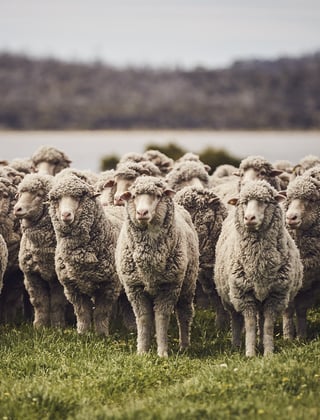The rise of sustainable fashion in China

Sustainability continues to be a dominant trend for textile and fashion industries across the world as they seek to improve the environmental and social impacts of their sourcing and manufacturing. This trend very much applies to China, the largest customer of Australian wool, which has made positive steps to be more sustainable.
As one of the world's largest textile and apparel producers, China plays a crucial role in shaping the future of sustainable fashion. This is especially relevant to the Australian wool industry because China is its most important customer, buying about 80% of all Australian wool for processing, with about half that wool subsequently being bought at retail in China.
AWI Country Manager for China, Jeff Ma, says there continues to be a growing interest in sustainable fashion in China, like in many other parts of the world, and Australian wool is well placed to take advantage of this trend.
“In recent years in China, there has been more and more attention paid to addressing the environmental challenges in the textile and apparel industry,” Jeff said.
“The emergence of sustainable fashion and consumption in China can be attributed to a combination of the Chinese Government’s shift in economic policy and textile industry strategy, and manufacturers and brands responding to growing consumer concerns for the environment.
“Collaborative efforts between the Chinese Government, industry stakeholders and a growing mass of conscious consumers is playing a vigorous role in driving sustainable fashion’s success in China.”
- Jeff Ma, AWI Country Manager for China
Chinese Government shift in economic focus
In recent years, China has shifted its emphasis away from quantity of economic growth towards quality of growth as a key guiding policy principle. The country’s 14th Five-Year Plan (2021-2025) focusses on “high-quality development” which it defines as innovation-driven, balanced, green, open and inclusive growth.
China aims to establish an economic system of green, low-carbon and circular development, which will be the priority of China’s policy makers for the foreseeable future. The country has set ambitious goals of peaking carbon dioxide emissions by 2030 and achieving carbon neutrality before 2060.
Chinese textiles and apparel industry going green
China intends to continue to develop a greener and more sustainable textiles and apparel industry. However, instead of simply reducing pollutants and water usage, China plans to develop a sustainability-led growth model, emphasising areas including the circular economy and creating new value-added products based on recycled material.
In line with the Government’s 14th Five-Year Plan, the China National Textile and Apparel Council (CNTAC) has introduced guidance and policies to achieve the goal of becoming “the main driver of the world’s apparel technology, an important leader of global fashion, and a powerful pioneer of sustainable development” by 2035.
In June 2021, CNTAC launched its ‘30:60 Carbon Neutrality Acceleration Plan’ to support 30 key brands and 60 key manufacturers to carry out carbon neutral activities and set an example to its peers in the industry. As of September 2023, 21 brands, 42 manufacturers and three key textile hubs have joined the Plan and are actively promoting low-carbon technologies and products, while also jointly promoting industry climate action.
“There are many emerging and established fashion brands that have integrated sustainable development into their corporate values and long-term strategic planning. At an operational level, the consumer education and awareness campaigns of many brands are encouraging consumers to embrace more sustainable, healthy, green lifestyles,” Jeff said.
Growth in Chinese conscious consumers
Although sustainability is still a relatively new concept to Chinese consumers, a notable driving force is the younger generation in China. With higher education and income levels, young Chinese individuals are notably inclined to buy products they regard as sustainable.
Furthermore, people in the growing upper-middle and high-income classes are not only choosing to buy eco-friendly fashion products, they are also actually willing to spend more for them.
“Amidst a recovering post-COVID economy, conscious consumers are prioritising quality over quantity, and are more curious and willing to spend on items that will last and tell a compelling sustainability story,” Jeff said.
“Chinese consumers are digitally savvy and know how to educate themselves about the provenance and specifications of products – and, compared to the average consumer globally, the Chinese are more likely to choose brands with traceable sources and transparent origins.”
AWI marketing strategy

Marketing collateral by Chinese apparel brand NEIWAI for a Woolmark-certified Merino wool collection that was fully traceable through the supply chain back to the specific farm in Australia that produced the wool.
AWI’s marketing strategy in China is closely aligned to the shift towards sustainability in this important market for Australian wool.
For example, AWI’s subsidiary The Woolmark Company continues to develop collaborations with brands, such as Edition (see the article in this edition) and NEIWAI (see above), that showcase to consumers in China the farm to fashion journey of Australian wool.
In addition, The Woolmark Company’s consumer marketing campaigns in China highlight the eco-credentials of wool: the company’s Spring/Summer 2023 campaign highlighted wool’s biodegradability, and the current Autumn/Winer 2023 campaign highlights the regenerative and healing nature of wool-growing.
“As a natural, renewable and biodegradable fibre, Australian wool has a great story to tell. As long as Australian woolgrowers continue to ensure that their on-farm practices align with the sustainability expectations of its customers, the wool industry can be on the front foot in promoting the fibre’s eco-credentials,” Jeff added.
This article appeared in the December 2023 edition of AWI’s Beyond the Bale magazine. Reproduction of the article is encouraged.














